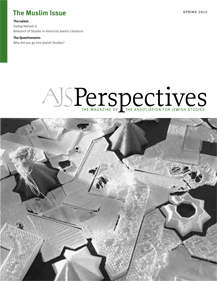Dear Colleagues,
Since the mid-1990s, the AJS has structured its conference submission and evaluation process around a set of roughly twenty division themes. These themes have informed how scholars have shaped their proposals, identified their work, and reached conference audiences. Largely organized around geographical, chronological, disciplinary, and linguistic rubrics, the division structure has worked well for many members whose work falls within clear disciplinary boundaries—Professor X is a modern Jewish historian, and thus submits her proposal to the Modern Jewish History division; Professor Y is an art historian and thus submits his work to Jews and the Arts.
At the same time this division structure has been in place, the AJS conference has grown in participation and scope, with more than 160 sessions and 1,000 attendees. Looking back at the conference program from 1974, one finds a total of seven sessions: "The Impact of the State of Israel on Jewish Thought," "New Idioms in Israeli Literature," "Archival Research in Judaica: Resources and Problems," "The Shifting Roles of the Rabbi and the Jewish Scholar," "Literary Criticism of the Bible: the Comparative Approach," "Tensions and Adjustments in East European Jewish Identity during the Last Decades of the Tsarist Regime," and "Achievements and Horizons in Qumran Studies." In 1987, the number of sessions had grown to 47; in 1995, the number reached 78. Now double that in size, the AJS conference needs to accommodate an increasingly diverse group of scholars, representing the breadth of humanities and social science disciplines, in a manner that does not splinter the field into micro-units while at the same time recognizes the highly interdisciplinary nature of many scholars' work.
In response, over the past decade, the conference program committee has sought to make the divisions more flexible and accommodating to scholars' shifting interests and methodologies, adding the term "studies" to several areas which had once only embodied one disciplinary approach; thus Yiddish Literature became Yiddish Studies, Holocaust History became Holocaust Studies, etc. The committee also created the Special Topics/Interdisciplinary Division to provide a home for proposals that did not fall neatly within one division or another (and often reflected multiple divisions subject areas). Interestingly, the Interdisciplinary Division has witnessed some of the greatest growth in submissions over the past five years, as scholars across literatures, languages, time periods, and regional specialties have joined together in panels to ask new questions in new ways.
The program committee, made up of scholars across Jewish Studies and chaired by the vice president for program, Reuven Firestone, is now undertaking a re-evaluation of the division structure as a whole. Recognizing that the field of Jewish Studies, and the humanities and social sciences more generally, have changed in significant ways since the time that the division structure was formulated, the program committee seeks to ensure that the conference framework is still reflecting—and pushing—the field in the most challenging and useful of ways. The committee will be asking questions such as: Do the divisions reflect the way Jewish Studies scholars think, write, and work? Is the structure responsive to the AJS's multigenerational membership and the different ways in which they have been trained? Do the divisions facilitate and allow for new forms of scholarly collaboration? Do they encourage scholars to approach a problem in a manner they want to or, better yet, in a manner they hadn't thought to before?
Fortunately, there are many models to turn to. Some learned societies provide one overarching theme for its annual meeting, seeking to encourage scholars to consider a particular issue from a range of perspectives. Other societies provide a roster of semipermanent topics, akin to the current AJS division structure and reflecting discrete subjects of study, but also offer special topics approved for a shorter period of time (i.e. three to five years) as a way to encourage exploration of new issues (these topics are proposed and overseen by members). A few societies do not provide any rubrics at all, and allow themes to arise from the submissions. We will be looking to other societies for creative and practical models, as well as turning to you, the membership, to find out what you think of the current division structure, and what would make the conference an even more useful intellectual and professional experience. Please be on the lookout for requests for your input in the coming months.
Along these lines, the AJS will also be improving its communication about conference processes and policies, ensuring that members understand who is charged with evaluating their proposals and devising the conference program. We are developing a clear set of guidelines regarding who can serve as division coordinator and program committee member, how these positions are selected, and what their terms of office are. These policies will be made public on the AJS website. Please e-mail me at ajs@ajs.cjh.org if you have any other thoughts on this topic. As always, thanks for making the AJS conference such a successful event year after year. I look forward to seeing you in Chicago.
Rona Sheramy
Association for Jewish Studies

